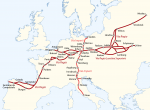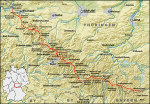We previously established the fundamentals of world-building; with a world’s basic rules down, it’s important to consider how you get around in that world. And travel was very different (read: slower) in a medieval setting.
It’s Not That Far…
As explained by Rick Stump in “Modern Minds and Medieval Distances,” there’s a psychological aspect to travel that should be considered when role-playing in a medieval world. There’s an old saying that 100 years is a long time to Americans but not to Europeans, while 100 miles is not far to an American but far for a European. The time or distance doesn’t change, of course, but the perception is quite different.
Maps can also be deceiving. Nowadays in Western countries there are usually paved roads from most anywhere to anywhere. So when you look at a map you think of distance as closely related to the number of inches between two points on the map. But this varies with terrain and especially with technology.
I’m in the early stages of designing a game about the American Civil War (ACW), and of course I knew that the war tended to be divided into eastern and western theaters. The reason is obvious on a certain kind of map, one that shows railroad lines or one that shows the Appalachian Mountains as a barrier, as they were in those days when the railroad lines didn’t go through the mountains. Railroads were the vital method of transportation for ACW armies.
Or look at a map of the Roman Empire. What’s not obvious is that water transportation was much quicker and much cheaper than land transportation, even with the fine Roman road network. So if you just look at the map you get a completely skewed idea of how transportation (and communication) worked.
I once found online an interactive map that showed the weeks of transportation from Rome (it's gone now, but Orbis is similar). You can easily see that it would be quicker to transport something from Rome to southern Spain than from Rome to northern Italy, especially because there are not big north-south running rivers in Italy sort of analogous to the Mississippi River in the United States. River transport was much cheaper than land.
Or is It?
The standard method of transportation in medieval times was walking. Even if you had a cart to carry goods you weren’t going to ride on that cart very much, nor would a cart with solid wooden wheels go very fast. At normal walking speed, which about 3 mph, it takes a heck of a long time to get most anywhere!
Yes, we have examples of forced marches by military units in times before mechanization that are sometimes mind-boggling, as much as 50 miles in 24 hours, though more commonly 20 miles in 24 hours. What you don’t hear about such events is that a lot of soldiers did not get to the end of the march, they dropped out for various reasons or struggled along far behind.
The U.S. Army 30 years ago would periodically send their troops on “12-mile road marches,” carrying about 80 pounds of equipment; that really wore out the guys I knew, who of course weren’t doing it every day, and did not look forward to it. I think the farthest I’ve ever walked in one day was 7 miles, without a backpack, and it sure ruined me for a while (thanks partly to flat feet).
Riding a horse would make this somewhat more comfortable but not much faster. Even when you ride a horse, for a significant part of a long journey you’re walking and leading the horse. Or you won’t end up with much of a horse.
You can see how much difference magical automobiles would make in a medieval world (provided roads are available . . .), let alone something like a magic carpet. We lose some of the sense of wonder such items would invoke in medieval inhabitants because we’re accustomed to modern technology. Even something as simple as a walkie-talkie with good range would be a great wonder in a medieval world, and very useful to military operations or dungeon and wilderness adventures. Splitting the party (which as we all know “you should never do”) would be much safer and more useful with a walkie-talkie set.
Yes, our fantasy characters are tougher than we are, and more inured to drudgery, but we should keep in mind the difference between a non-mechanized society and a modern highly mechanized society, both as players and as world builders.
It’s Not That Far…
As explained by Rick Stump in “Modern Minds and Medieval Distances,” there’s a psychological aspect to travel that should be considered when role-playing in a medieval world. There’s an old saying that 100 years is a long time to Americans but not to Europeans, while 100 miles is not far to an American but far for a European. The time or distance doesn’t change, of course, but the perception is quite different.
Maps can also be deceiving. Nowadays in Western countries there are usually paved roads from most anywhere to anywhere. So when you look at a map you think of distance as closely related to the number of inches between two points on the map. But this varies with terrain and especially with technology.
I’m in the early stages of designing a game about the American Civil War (ACW), and of course I knew that the war tended to be divided into eastern and western theaters. The reason is obvious on a certain kind of map, one that shows railroad lines or one that shows the Appalachian Mountains as a barrier, as they were in those days when the railroad lines didn’t go through the mountains. Railroads were the vital method of transportation for ACW armies.
Or look at a map of the Roman Empire. What’s not obvious is that water transportation was much quicker and much cheaper than land transportation, even with the fine Roman road network. So if you just look at the map you get a completely skewed idea of how transportation (and communication) worked.
I once found online an interactive map that showed the weeks of transportation from Rome (it's gone now, but Orbis is similar). You can easily see that it would be quicker to transport something from Rome to southern Spain than from Rome to northern Italy, especially because there are not big north-south running rivers in Italy sort of analogous to the Mississippi River in the United States. River transport was much cheaper than land.
Or is It?
The standard method of transportation in medieval times was walking. Even if you had a cart to carry goods you weren’t going to ride on that cart very much, nor would a cart with solid wooden wheels go very fast. At normal walking speed, which about 3 mph, it takes a heck of a long time to get most anywhere!
Yes, we have examples of forced marches by military units in times before mechanization that are sometimes mind-boggling, as much as 50 miles in 24 hours, though more commonly 20 miles in 24 hours. What you don’t hear about such events is that a lot of soldiers did not get to the end of the march, they dropped out for various reasons or struggled along far behind.
The U.S. Army 30 years ago would periodically send their troops on “12-mile road marches,” carrying about 80 pounds of equipment; that really wore out the guys I knew, who of course weren’t doing it every day, and did not look forward to it. I think the farthest I’ve ever walked in one day was 7 miles, without a backpack, and it sure ruined me for a while (thanks partly to flat feet).
Riding a horse would make this somewhat more comfortable but not much faster. Even when you ride a horse, for a significant part of a long journey you’re walking and leading the horse. Or you won’t end up with much of a horse.
You can see how much difference magical automobiles would make in a medieval world (provided roads are available . . .), let alone something like a magic carpet. We lose some of the sense of wonder such items would invoke in medieval inhabitants because we’re accustomed to modern technology. Even something as simple as a walkie-talkie with good range would be a great wonder in a medieval world, and very useful to military operations or dungeon and wilderness adventures. Splitting the party (which as we all know “you should never do”) would be much safer and more useful with a walkie-talkie set.
Yes, our fantasy characters are tougher than we are, and more inured to drudgery, but we should keep in mind the difference between a non-mechanized society and a modern highly mechanized society, both as players and as world builders.






